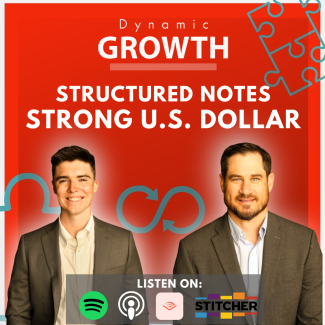
Structured Notes & Strength in the US Dollar
Today we’re kicking off with an interesting product to buy in a down market – structured notes. Let’s face it – when the market declines as we’ve seen recently, people are in search of growth! Quick recap for anyone keeping track – we are down:
- S&P 500 by 15-16%
- NASDAQ by 24-25%
Like it or not, we still believe the market needs more stability – think interest rates and inflation – before we hit the bottom of this downturn. So, as promised, today we want to introduce a product that many aren’t as familiar with, as perhaps it’s a decent fit for your portfolio. The reason these are so popular is due to the bear market. Since the market has already dropped significantly, the odds of it falling another 30% are not very probable. Possible, but not probable, in our opinion. As long as nothing major pops up and impacts the economy, the time to consider structured notes is now.
What are structured notes?
Issued by banks, structured notes are a combination of fixed income, debt security, and have a derivative component (track underlying metric). They can be bought for income or for growth but we’re focusing today on using them for income. Here are some highlights about notes:
- Have seen 8-23% interest crediting potential in the recent months
- Both parties can exit the note (but they are not as liquid as a stock)
- There are many variations to notes including time, coupon barriers, index tracking, notes with memory, principal protection, and more.
- A list of available notes comes out every month (pro tip: go with established banks that are unlikely to go out of business / close)
We scrub the available structured note products each month to see if any would be a good fit for our clients. If you ever have any questions about that list, please don’t hesitate to contact our office.
How structured notes work
To make it easier to explain, here’s a current example from Barclay’s. This particular structured note tracks the S&P 500 index and has a 70% coupon barrier, meaning as long as the S&P 500 doesn’t drop below 31% you still get your interest payout. At the end of the specified time horizon, you can get your principal back.
But everything comes with downside. The primary “watch out” with structured notes is liquidity. Your money is intended to be locked up for whatever period of time is specified in the note.
What’s in it for the bank
The bank makes money because they have access to funds for a set period of time. Meaning, they can take that money and now loan it out as many times as they need to – cars, homes, etc. – and since they know exactly when the notes come due, they can plan accordingly in terms of paying you back.
Now let’s turn our attention to the dollar
In a recent speech from Jerome Powell, he predicted a 75-basis point hike in September and another 50 in November. This is a tad higher than people were thinking and underscores that inflation is the only focus of the Fed. I guess we’ll see what happens this week when the inflation number comes out with the CPI number. After we saw “0% inflation increase in August” it will be telling for the effectiveness of the deceleration that has been taking place.
You may have noticed the dollar has been making headlines – or perhaps you keep hearing of friends planning trips to Europe. Well, here’s why – the DXY index is up 14.27% year to date and up 18.58% over the last 52 weeks. Keep in mind, over half of the DXY index is made up of the Euro – so that means the increase of the dollar is directly impacting the value of the Euro. So besides buying all the Rick Steves’ European travel books, what does this mean for us? The major challenge is servicing debt against the dollar – which many countries will now have a challenge with. Emerging markets with weaker currencies will find it especially hard with their international trade deals. When the dollar is strong, it helps US exports but hurts many other countries. Think about the impact this brings to countries like Germany where their input costs have risen by 200% and they certainly can’t pass that to their end users. It’s hard to remain competitive with these headwinds.
Ultimately, the strength of the dollar may cause a ripple effect for the fixed income market. Some even say this could be the straw that breaks the camel’s back (so to speak) that the Fed has been waiting for in terms of it’s tightening strategy. We’ll just have to wait and see.
Please note: This content is not a direct recommendation for investment. Investing involves risk including the potential loss of principal. Not all investments are suitable for all people. Crosby Advisory Group, LLC is a registered investment advisor in Ohio, Florida, and Texas.

